Meet your new brunch favorite: French Baked Eggs “Oeufs En Cocotte”, made the classic way with crème fraîche, Comté cheese, and a scattering of fresh chives. The ingredients are simple, the technique is easy, and the results? Silky, savory, and deeply satisfying. All you need is 5 ingredients and less than 20 minutes—and you’ve got a dish that’s as comforting as it is delicious.
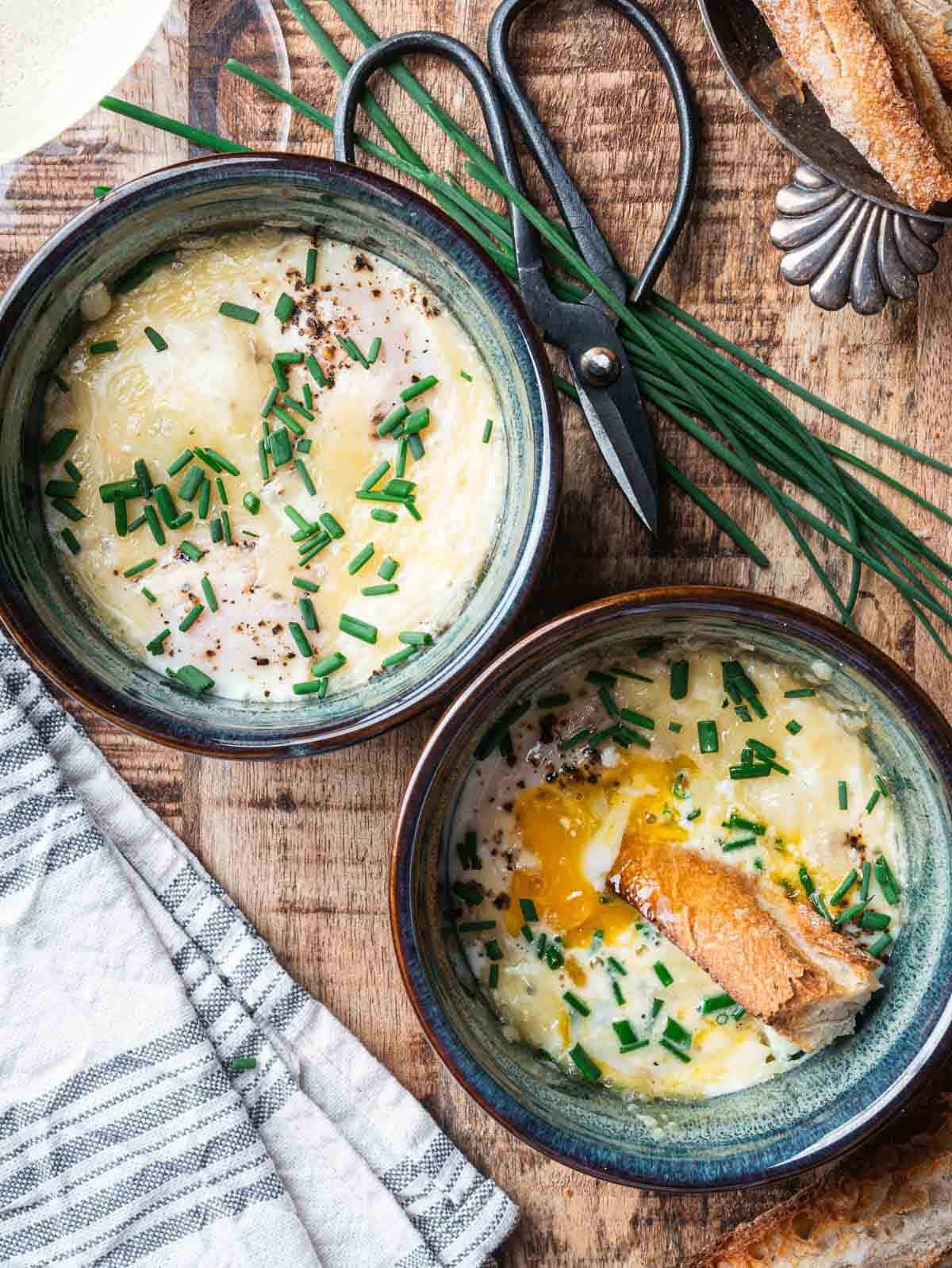
What are French Baked Eggs “Oeufs en Cocotte“?
French baked eggs, or oeufs en cocotte, are gently cooked in individual ramekins or mini cocottes. The method is straightforward: eggs nestled into a base of crème fraîche, with optional cheese and herbs, then baked until the whites are just set and the yolks remain luxuriously runny. Elegant yet unfussy, they’re just as fitting for a leisurely brunch as for a quiet, comforting dinner.
Why you should try this recipe
- Creamy, cozy, and just a little fancy – Crème fraîche, good cheese, and golden, runny yolks bake into something soft, rich, and deeply comforting. The texture is lush, almost custardy. It’s the kind of breakfast you want to linger over, toast in hand.
- Fast and easy – Five ingredients, twenty minutes, zero stress. These eggs are simple enough for a weekday, yet they have that effortless charm that makes them feel special. Perfect for a slow brunch or a last-minute breakfast-for-dinner situation. Add Brioche French Toast or Spinach and Goat Cheese Quiche and it becomes a full spread.
- Endlessly riffable – You can dress them up however you like. A spoonful of sautéed mushrooms, a handful of baby spinach, a few shavings of your favorite cheese. Fresh herbs: chives, thyme, maybe a little dill, lift everything. It’s a flexible, forgiving dish that rewards a little creativity.
Get 5 Days of 30-Minute Vegetarian Dinners – FREE!
Sign up TO MY EMAIL SERIES + NEW RECIPES
The ingredients you’ll need
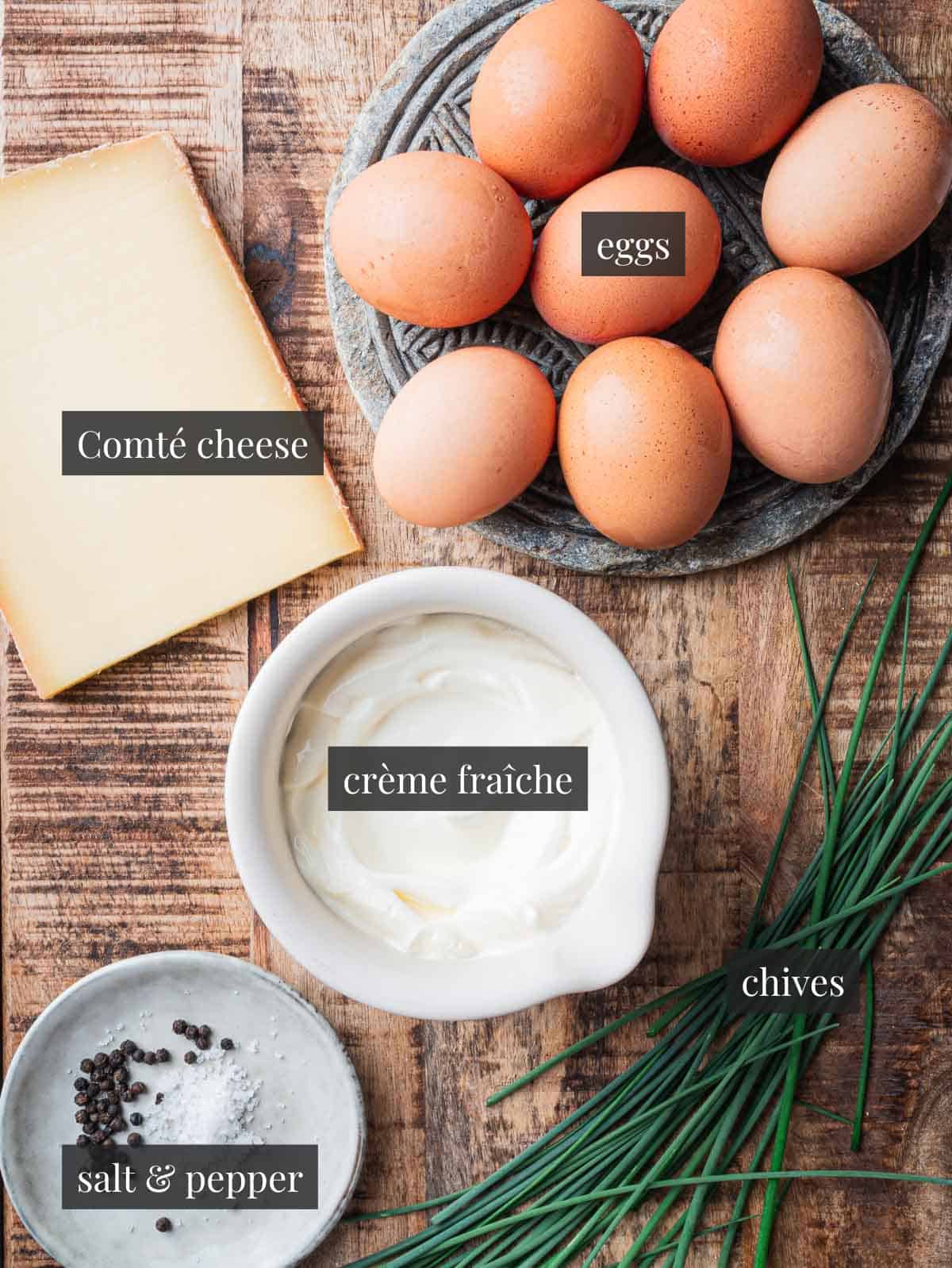
(Note: the full ingredients list, including measurements, is provided in the recipe card at the end of the post.)
- Crème fraîche – This lush, French-style cultured cream is rich, silky, and just the right amount of tangy. It melts beautifully into eggs, lending them a quiet decadence. If crème fraîche isn’t available, sour cream will work in a pinch—just know the flavor won’t be quite as deep or refined.
- Eggs – The centerpiece of the dish. Choose large, organic, free-range eggs if you can: their golden yolks and fresh flavor make all the difference when the eggs are front and center.
- Cheese – With its nutty, slightly fruity complexity, Comté brings a savory richness that’s hard to beat. If you have extra, shave it over roasted vegetables, fold it into Gougères (French Cheese Puffs), or use it in Vegetarian Spaghetti Squash With Spinach for a cozy, cheese-forward dinner. If Comté is hard to find, Gruyère or a sharp white Cheddar will bring a similarly satisfying flavor.
Love eggs? Check out my Poached Eggs In Cheese Sauce (Brie Cheese Sauce) or Çilbir (Turkish Eggs).
How to make French Baked Eggs?
(Note: please see the recipe card below for the complete written instructions and measurements.)
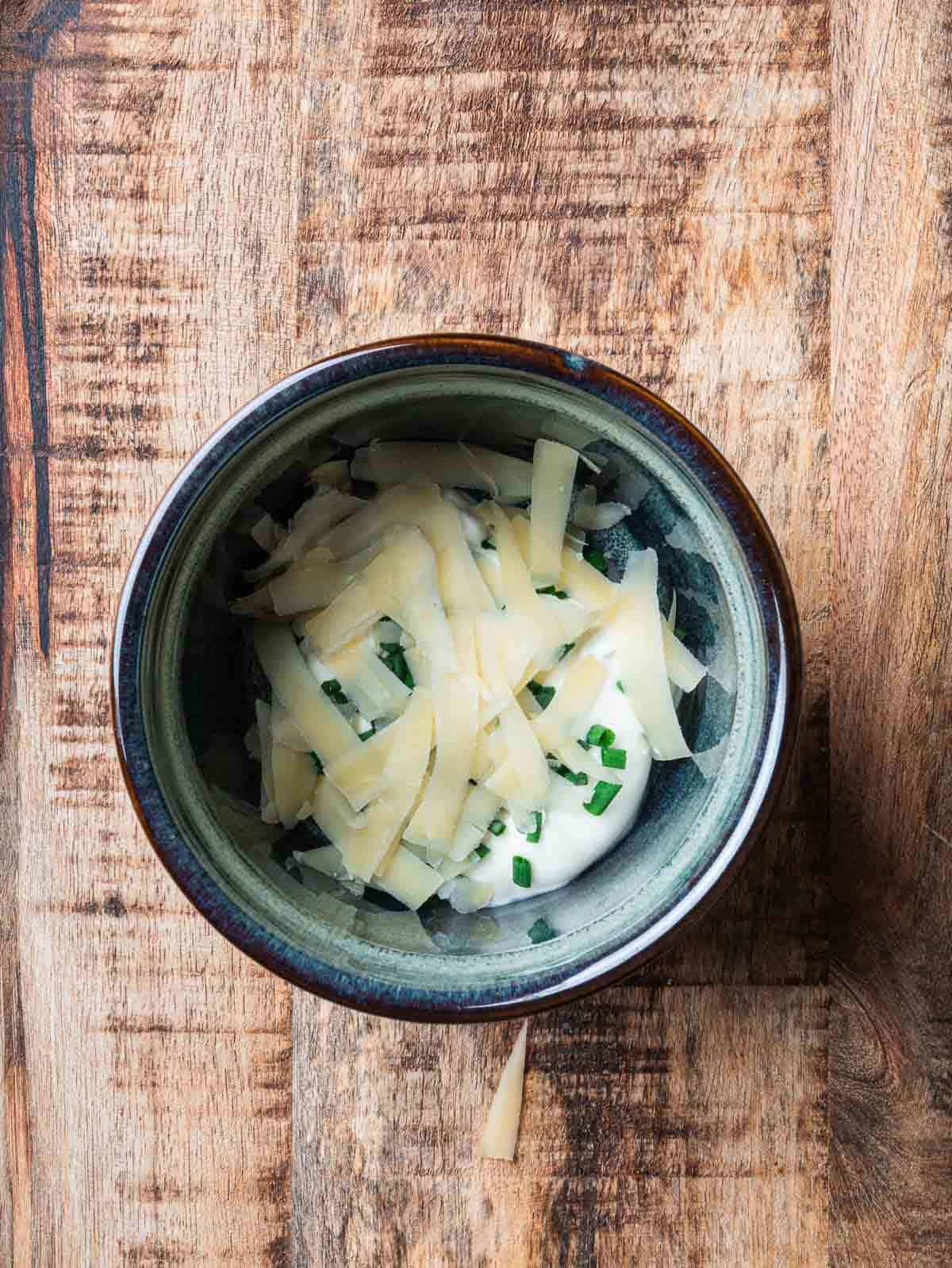
Step 1. Set up the ramekins – Preheat the oven to 355°F (180°C). Generously butter the inside of each ramekin with soft, room-temperature unsalted butter. Spoon 2 tablespoons of crème fraîche into the bottom of each, then sprinkle with 1 teaspoon of chopped chives and 1 tablespoon of grated Comté cheese.
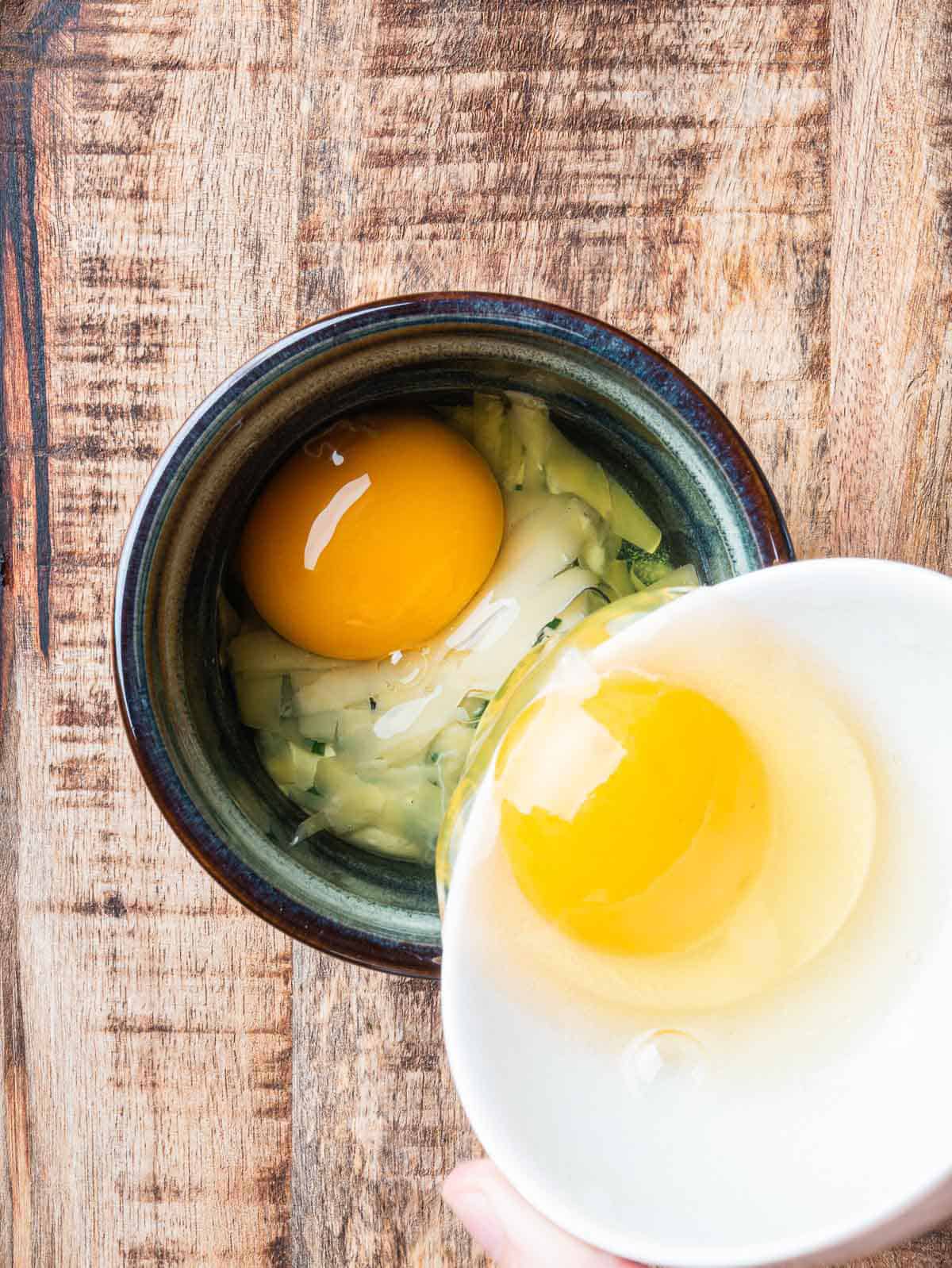
Step 2. Add the eggs – Crack one egg into a small cup at a time to avoid breaking the yolk or dropping any bits of shell. Gently slide each egg into the prepared ramekin, one by one.
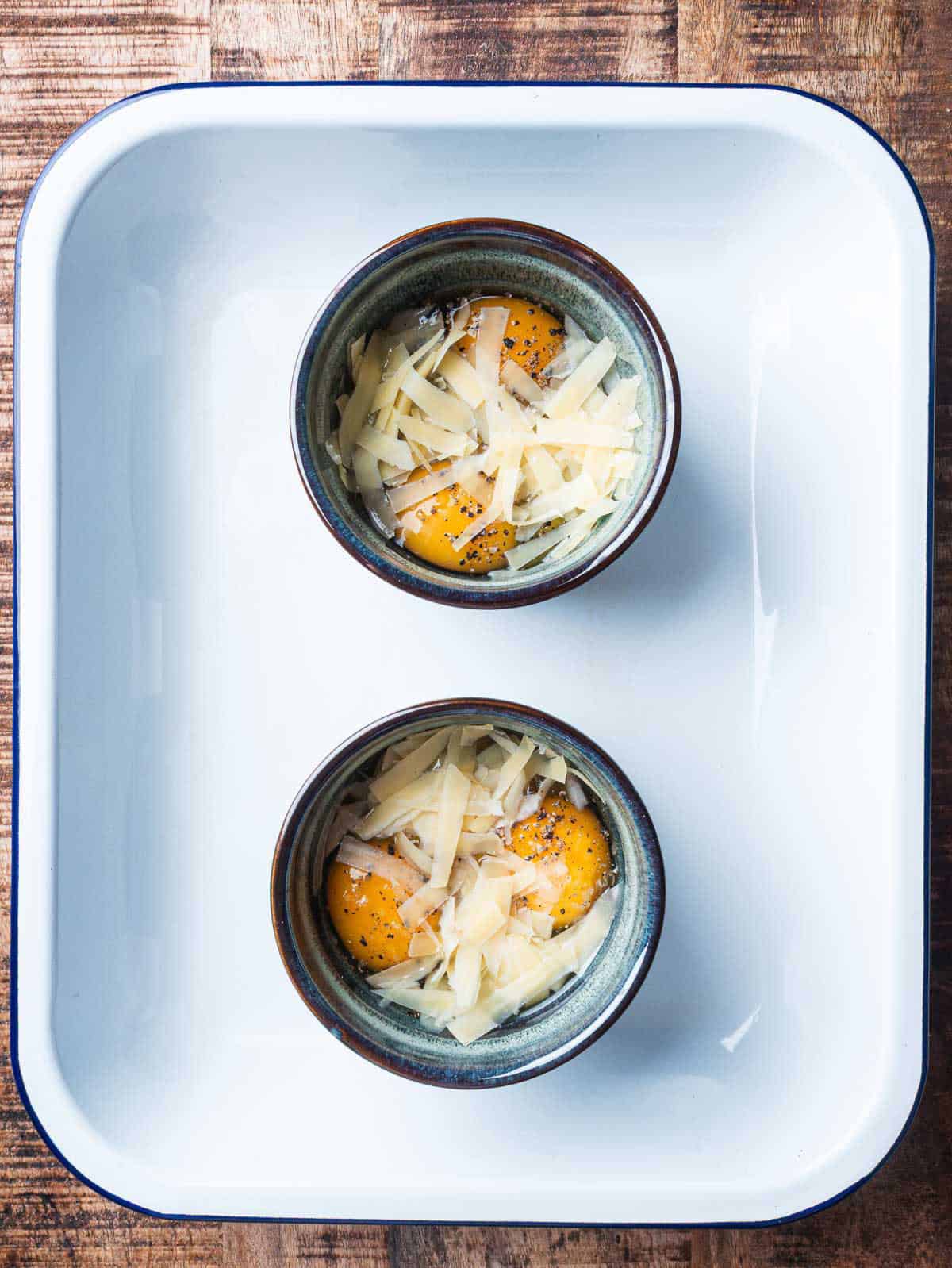
Step 3. Season and bake – Sprinkle with salt and pepper. Add 2 tablespoons of grated Comté over the top, making sure not to cover the yolks so you can easily keep an eye on doneness. Place the ramekins on a baking sheet or in a baking dish. Bake for 12 to 13 minutes, or until the whites are set and the yolks remain runny.

Step 4. Make the mouillettes (toasted bread fingers) – While the eggs bake, slice a 4-inch (10 cm) piece of baguette in half lengthwise and toast until golden.

Step 5. Then cut into thin fingers, about ½ inch (1.5 cm) wide.
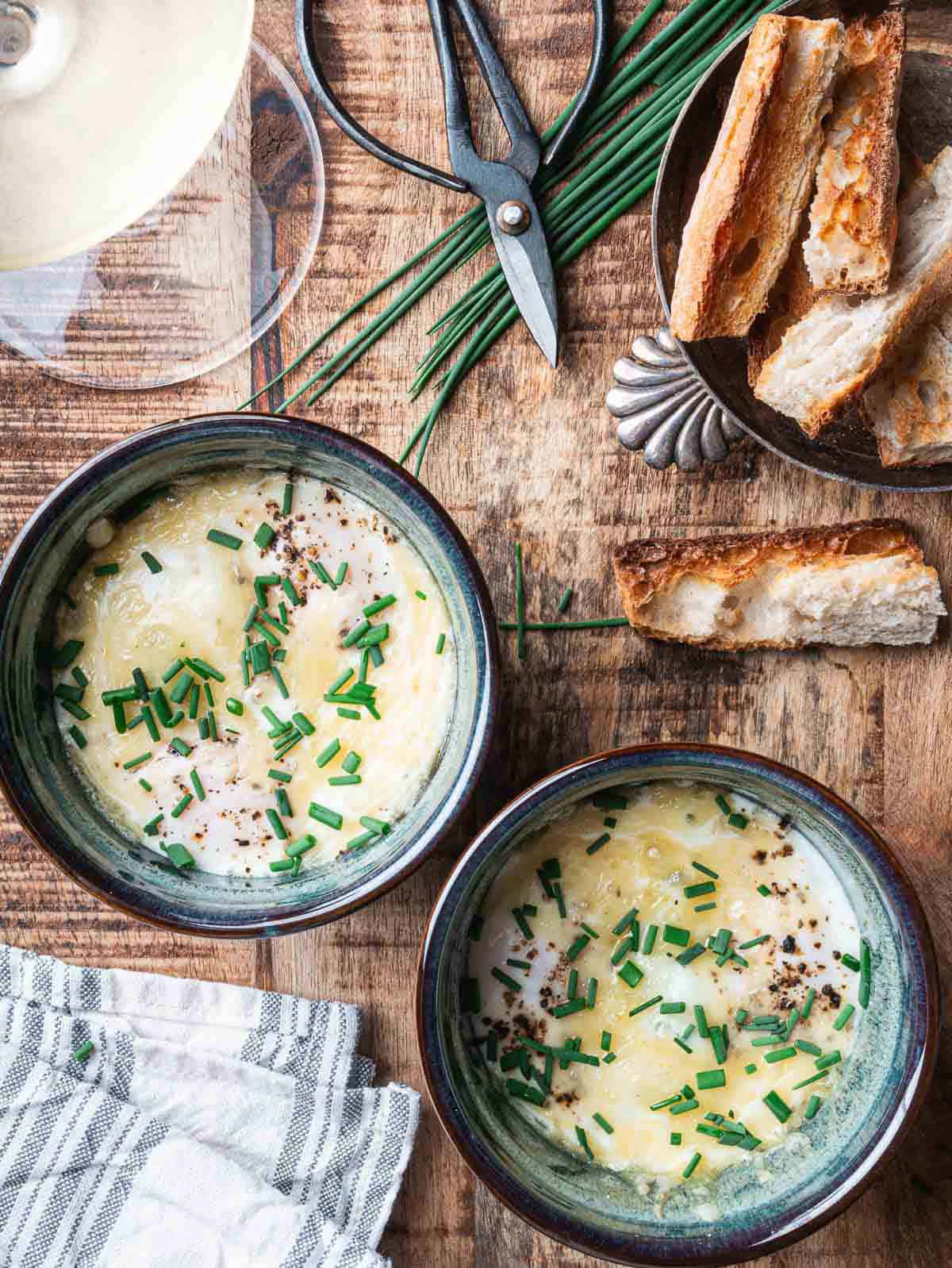
Step 6. Garnish and serve – Remove the ramekins from the oven and sprinkle with extra chopped chives. Serve immediately, with mouillettes on the side for dipping.
Nim Keys – French Baked Eggs Tips
- Skip the water bath – Traditionally, in France, oeufs en cocotte are baked in a water bath. But after a few rounds of testing, I found it doesn’t do much for the taste or texture here. What it does add is fuss—handling a baking dish full of hot water isn’t exactly how I want to start my morning. So skip it. The eggs still turn out beautifully.
- Use a sheet pan (or a baking dish) for ease – Ramekins can be tricky to handle with oven mitts. Sliding them into a sheet pan or baking dish first makes transferring them in and out of the oven a breeze.
- Don’t forget the “mouillettes” – The French have a charming tradition of dipping little toast “fingers” into runny yolks. Called mouillettes (pronounced moo-yet), these crunchy strips of toasted sourdough or baguette bring the perfect bit of texture. This recipe walks you through how to make them step-by-step, but a few slices of toasted bread will also do the trick.
- Watch your timing – Eggs can go from silky to solid in a blink, so keep an eye on the oven. Here’s a quick guide:
- 10 minutes: The whites are barely set, the yolks are very runny.
- 12 minutes: The yolks start to firm at the edges but stay soft in the center.
- 15 minutes: Both yolks and whites are fully set—no jiggle, no run.
Wine Pairing🍷
SPARKLING CHARDONNAY
A glass of Blanc de Blancs, a sparkling wine made entirely from Chardonnay grapes, is a lovely match for French Baked Eggs. Light and crisp with a touch of minerality, it often carries a subtle creaminess that echoes the richness of the eggs. The bubbles help cut through the crème fraîche and cheese, keeping each bite feeling fresh. It’s brunch with a bit of sparkle, just the way the French might do it.
Wine Appellation Suggestion:
Blanc de Blanc Champagne (France) or Blanc de Blancs Trento DOC from Trentino (Italy)

Recipe FAQs
These eggs are at their best straight from the oven, when the whites are just set and the yolks are still beautifully runny. They’ll continue to cook a bit from the residual heat, so serving them right away is ideal. That said, you can prep everything in advance: assemble the eggs in their ramekins ahead of time, then pop them in the oven just before serving.
No problem. Swap the crème fraîche for a plant-based sour cream or thick dairy-free yogurt, and simply skip the cheese. To add back a bit of depth and savoriness, try stirring in some sautéed mushrooms or leeks. Use a dairy-free butter substitute or a little olive oil to grease the ramekins.
If you tried this French Baked Eggs or any other recipe on my blog, please leave a ✨ star rating and let me know how it went in the ✍️ comments below! Merci!

French Baked Eggs “Oeufs En Cocotte”
PRINT SAVEEQUIPMENT
- 2 x 4-inch (10 cm) diameter ramekins (or mini cocottes)
INGREDIENTS
- room-temperature unsalted butter to grease the ramekins
- 4 tablespoons (60 g) crème fraîche (or sour cream)
- 4 teaspoons chopped chives
- 6 tablespoons (35 g) grated Comté (or mature Cheddar, Emmental, or Gruyère)
- 4 large free-range eggs
- kosher salt to season
- ground black pepper to season
- baguette or sourdough bread sliced and toasted or made into toasted finger bread (see recipe)
INSTRUCTIONS
- Set up the ramekins – Preheat the oven to 355°F (180°C). Generously butter the inside of each ramekin with soft, room-temperature unsalted butter. Spoon 2 tablespoons of crème fraîche into the bottom of each, then sprinkle with 1 teaspoon of chopped chives and 1 tablespoon of grated Comté cheese.
- Add the eggs – Crack one egg into a small cup at a time to avoid breaking the yolk or dropping any bits of shell. Gently slide each egg into the prepared ramekin, one by one.
- Season and bake – Sprinkle with salt and pepper. Add 2 tablespoons of grated Comté over the top, making sure not to cover the yolks so you can easily keep an eye on doneness. Place the ramekins on a baking sheet or in a baking dish. Bake for 12 to 13 minutes, or until the whites are set and the yolks remain runny.
- Make the mouillettes (toasted bread fingers) – While the eggs bake, slice a 4-inch (10 cm) piece of baguette in half lengthwise and toast until golden. Then cut into thin fingers, about ½ inch (1.5 cm) wide.
- Garnish and serve – Remove the ramekins from the oven and sprinkle with an extra teaspoon of chopped chives. Serve hot, with mouillettes on the side for dipping.
NOTES
- Skip the water bath – Traditionally, in France, oeufs en cocotte are baked in a water bath. But after a few rounds of testing, I found it doesn’t do much for the taste or texture here. What it does add is fuss—handling a baking dish full of hot water isn’t exactly how I want to start my morning. So skip it. The eggs still turn out beautifully.
- Use a sheet pan (or a baking dish) for ease – Ramekins can be tricky to handle with oven mitts. Sliding them into a sheet pan or baking dish first makes transferring them in and out of the oven a breeze.
- Don’t forget the “mouillettes” – The French have a charming tradition of dipping little toast “fingers” into runny yolks. Called mouillettes (pronounced moo-yet), these crunchy strips of toasted sourdough or baguette bring the perfect bit of texture. This recipe walks you through how to make them step-by-step, but a few slices of toasted bread will also do the trick.
- Watch your timing – Eggs can go from silky to solid in a blink, so keep an eye on the oven. Here’s a quick guide:
- 10 minutes: The whites are barely set, the yolks are very runny.
- 12 minutes: The yolks start to firm at the edges but stay soft in the center.
- 15 minutes: Both yolks and whites are fully set—no jiggle, no run.








Wasn’t sure if I could pull this off before coffee, but turns out it’s super doable, and so worth it. My eggs were jammy in the best way, and I may never skip mouillettes again. Thank you for sharing!
So glad it worked out, especially pre-coffee, that’s impressive! Thanks so much for making it!
I tried it with emmental. It was great!
Great to hear, Janna! I love making it with Emmental too 🙂